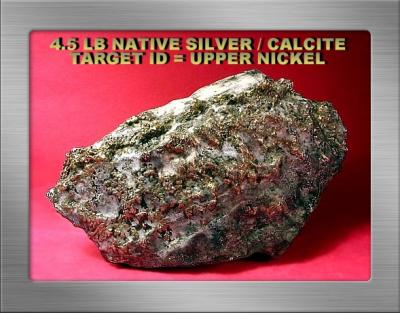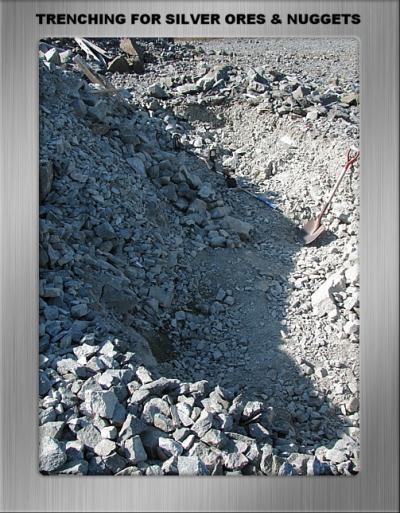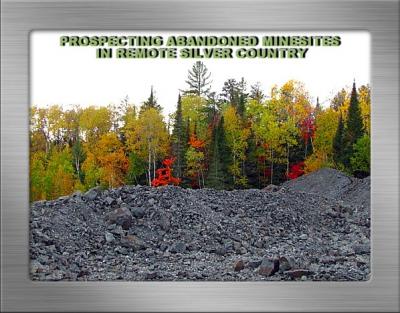-
Posts
251 -
Joined
-
Last visited
Content Type
Forums
Detector Prospector Home
Detector Database
Downloads
Posts posted by Jim Hemmingway
-
-
On 2/1/2016 at 1:43 PM, Steve Herschbach said:
OK, if people have not figured it out yet when something attracts my attention I can go kind of nuts over it. The flip side is once I get distracted by the latest new thing that fires my imagination I may wander off the previous item for some time before getting back to it. Such has been the ATX project. I never leave things undone however and this one has got to get off the "to do" list.
Anyway, I am running out of project time before it is time to get serious about prospecting again so time to bring this thread back to life. Do not expect results tomorrow but I am going to get this wrapped up this month.
Good Steve, I've followed this thread with much interest and wish you the best possible results with this project... many thanks for sharing your progress with us.
Jim.
-
Sweet ! Who cares what the final weight was of your "klinkers".
Sounds like you found it interesting, enjoyable and had fun .... what else matters.
Have fun with your next adventure !
Couldn't say it better Dick!!! There's no stopping a determined prospector I guess... good stuff Tom!!!

Jim.
-
More intriguing to me is a trick a GMT user told me about years ago, but I keep forgetting to try it. He claimed the mineralization meter could be used as an extra aid in identifying ferrous items.
Steve this has been suggested to me over the years, and I've read a few accounts on the forums.
"The way Fe3O4 (or equivalent) is measured internally in different machines, is different, so it's hard to generalize what it'll do on metal targets. On some machines on some targets and in some soils it can be an aid in identifying flat or rusty iron." That is a direct quote taken from an email to me from a chief design engineer in El Paso who certainly ought to know.
My F75 Fe3O4 meter will respond to rusted iron in the ground conditions here, but it will respond similarly over some perfectly good, rich silver ores in situ.
When seeking more information about a suspect target, I use the groundgrab feature prior to disturbing the soil. Pinpoint the target, enable the groundgrab and pump the coil no more than four or five times. That's plenty, so don't force the issue.
Observe the ground phase / GB readout. In this area a sharp reduction from typical operating values of around GB86 to more conductive GB values... for example say low GB40s... is a clear indication of either rusted iron (maghemite formation in surrounding matrix), predominantly colbaltite ores (arsenic rich) that may or not possibly contain some negligible amount of native silver, or niccolite... a commonplace nickel arsenide in this area.. but our typical dollar-size nickel ores tend to generate comparatively less conductive values in the GB50s.
Jim.
-
Thanks Bob, we never know what the season holds in store. Last year was almost a complete washout with endless rainfalls of biblical proportions, eventually followed by cold and snow. I had felt lucky to get out of that area with my camper in tow. This year I have no presentiment of good luck, so I suppose we’ll have to work at it and hope for the best. No matter… I enjoy that environment, and thoroughly enjoy detecting for rocks. It is the one thing, besides fly-fishing, that has remained an avid lifetime interest.I’ll see about writing you a good long letter about the trip within a month or so of returning home. Hope you have experienced a good, solid season to date. All the very best to you and the family, and so long for now.Jim.
-
Hi Fred… the point I was trying to convey above is that at least in this prospecting application, things are fairly healthy for consistently successful hunters, and likewise regarding specimen market values. It does pay to be selective about where and how a product is marketed.There is much less surface detectable silver to be found nowadays certainly, but the surface pickings weren’t all that great when I entered the hobby some 30 years ago. The “electronic prospecting rush” was pretty much over by that time in this area, and yet I’m well acquainted with several top hunters who currently supplement their income nicely by marketing silver largely outside Ontario.All the very best with your prospecting season Fred, I'm heading to the north country within a few days and will be absent from the forums for several months. Good luck and good hunting.
 Jim.
Jim.
-
I would read Jim's him stuff about his great silver specimens and think - gosh it would be wonderful to get to go hunting with him - forget about it - that kind of trench is exactly why I stayed out of the infantry.
Lol
Ahhh Rick… what a hilarious sense of humor!!! I think that it would be interesting to apply your astute powers of observation and analytical inclination to this application in northeastern Ontario. There can be no doubt that combining our resources would prove to be a lot of fun, and heck… we might even find some worthwhile silver or related minerals!!I love to explore for potential sites, with a result that occasional good material is found as a mere happenstance. But the key is to locate deposits… and of course ultimately that leads to excavations. I see no reason why you couldn’t accompany me in a supervisory role once we partake of a few drinks at the local watering hole. My friends could comfortably transport you out to the treasure site as depicted below.I normally dig roughly two-and-a-half to three-foot deep trenches to see what gives. It’s not terribly unusual to dig to seven-foot depths or more where silver stringers continue to surface. But it’s certainly not all work and no play. I enjoy metal detecting regardless of what is found. Identifying silver distribution patterns over large areas, and predicting and investigating deep signals with either PI or VLF units is a lot of fun. And by and large... that is how we find good silver.mn90403… Mitchel… if you click on the link below, it will direct you to the first of several lengthier articles that I’ve posted over the years. These copies are stored on the “Canada” sub-forum at TreasureNet. You might wish to log into the forum as this permits you to see silver photos full-size, otherwise you must click on each photo individually to do so.The samples displayed on forums do have some relationship to bullion value, albeit in many cases that is not a terribly serious consideration to me as a potential seller. By comparison, crystalline silver or the various dendritic forms, sponge and particulate native silver, especially those in close association with related minerals… particularly the ruby silvers, for example proustite crystals… are worth many times their bullion value. Some such specimens are very ordinary in my experience, but there it is.Jim. -
Hard Prospector partial quote:
"the writings still on the wall. All the pieces I've detected in the last 6 months came from moving tailing piles, raking or digging BEFORE swinging, resulting in some nice finds but it took lots of work and patience. Wandering across the desert while swinging is what I enjoy most but I'm beginning to accept that to stay productive with my detector, this is what I have to do."
Rob... a no BS observation that applies to my area as well. Oh sure, we can still wander about and occasionally find something worthwhile, but most such surface material is long gone. And despite occasional superlative large silver floats found in the outback, 99% of such floats are comprised of undesirable arsenides, not to mention that it is an iron-clad bitch to dig any of it in the heavy bush.
I've been doing exactly what you suggest for many years and doing it successfully. I pick my sites based on firsthand sampling experienced over the years and move a lot of material as per the photo below. In this application, I feel no motivation to acquire even deeperseeking units. What I do make good use of is a strong back, good leather gloves, a sturdy pick and shovel that can get the job done as efficiently as possible. Welcome to the real world of mineral collecting, or in this instance silver collecting. Thanks Rob.
Jim.
-
Holy Cow John, I’m not the least bit offended. On the contrary, reading your above post last night gave me a good laugh. I was thinking at the time that you have a great sense of humor, and how nice it was that you remembered me despite that I haven’t been active on the forum lately.We’re lucky to have these forums, but I don’t think that computers are always ideal at conveying our thoughts or emotional responses. I really shouldn’t post late at night, particularly after a couple of glasses of brandy. I tend to wax philosophic rather than speak directly to the point. I hope this will clear away any doubts whatsoever, because I do enjoy your posts and was especially pleased with your reference to me. Lets carry on and no worries. All the very best.
 Jim.
Jim.
-
WTG Dean, congratulations on that beautiful gold.

Jim.
-
Jasong… thankyou for a fantastic synopsis about using drone capabilities to improve our effectiveness in the field. One can easily forecast the potential returns in the areas of Ontario and northern Appalachians that we frequently visit. I didn’t pay much attention to this information until reading your input on this thread and fully appreciated the possibilities.John… I’m glad this was brought to my notice because I haven’t been terribly active here just lately. Our family has just returned from the Atlantic shores and so I’ll keep this reply brief.I’ve always enjoyed your terrific sense of humor over the years, and it certainly does enliven these forums… I suppose I should thank you for the above honorable mention!!! I won’t say that I always necessarily agree with all of your technical insights, but that doesn’t matter to me in the least. I do enjoy reading your contributions and following your thought processes. The important thing is that I have always been, and always shall be, your friend.Jim.
-
Relichunter... that is a genuinely beautiful, rugged specimen, I don't recollect ever seeing anything posted to these forums that I liked nearly so much as your piece. I can only imagine your feelings when it came out of the ground. Congratulations are very much in order!!!

Jim.
-
Thanks Dean for taking us along on your visit to the micro-nugget gulch, and congratulations on those finds... any gold is good gold. That one little piece is particularly attractive and shapely if such a description could apply to valuable rocks.
I suggest you take a good close-up photo of that 'hotrock' outside in natural lighting. If you have a VLF unit it would help to know its target ID and more importantly its GB compensation point on a VLF GB scale. Does it possess any unusual property. for example... weight, streak, metallic luster or color anyplace on the rock, is it particularly hard or soft, and when rubbed on your damp thumb does it leave any residue or black stain, and / or anything else that you notice.
Jim.
-
Good for you Scott, hope you find plenty more.

Jim.
-
Hi Kenny… over on the Dankowski forum I see that Keith did a video on the F75 in his test plot and got surprisingly good depth on a nickel with that 10” elliptical DD coil. In terms of magnetic susceptible strength his ground is similar to mine, but there is something else about that type of ground that allows his detectors to obtain pretty decent tones on his deep, planted targets. As I mentioned above, that just won’t happen here because coins beyond five or six inches depth read as iron.I would like to try the latest model you have purchased, it sounds like it is an outstanding unit. But for prospecting / tailing searching in remote areas I have found my original F75 to be quite stable, so there hasn’t been much justification for upgrading it. In the silverfields here, the motion all-metal mode is particularly stable at maximum gain, in fact much more than is my MXT in its motion all-metal prospecting mode.While I haven’t used one, I can’t help but think that your 10” elliptical DD will be a significant improvement over the stock 11” elliptical DD for small nuggets. While the 11” elliptical DD is fine for this area where the silver is relatively large, it does lack sensitivity to small stuff. My 10” elliptical concentric markedly improves sensitivity in that regard, and the 5” round DD or especially the 6½” elliptical concentric… my favorite coil for small stuff… makes this unit very capable over sub-grainers.Don’t worry about replying to this post Kenny, my main goal here was simply to reiterate what a pleasure it has been to chat back and forth with you about this unit… thankyou for being such a good conversationalist. Good luck with your F75, we’ll be in touch I’m sure… especially if I see a future post about your F75 detecting activities. Happy Trails!!!
 Jim.
Jim.
-
Spencer@wy... while I have never experienced it over here in our temperate weather conditions, I've read that heated surfaces affect ground mineral reactivity and / or somehow otherwise affect metal detection stability. I think you've hit the nail on the head when you relate it directly to weather conditions.

Jim.
-
Beautiful nuggets Scott, congratulations following-up your research with persistence in the field. That specimen above is absolutely in the twilight zone. WTG!!!

Jim.
-
Hi Kenny… just another few remarks in response to your findings to date. The F75 discrimination modes do process ground mineral and target signals differently. Employing zero discrimination in any F75 discrimination mode to eliminate those mafic negative hotrock signals, while simultaneously acquiring the best possible discrimination mode detection depth and making good use of iron tones… is a great combination. Aside from masking issues, keep in mind that iron tones will sometimes be applied to non-ferrous targets at depth… particularly in elevated ferromagnetic substrates. Listen for any hint of regular tones and although it can be frustrating at times… try to habituate yourself to digging the weaker iron tones if you think the conditions / prospects warrant it.
Nowadays I rarely use discrimination modes, unless small iron tidbits, small nails or beds of numerous hotrocks are troublesome to the point of distraction. Most of our searching is done in the motion all-metal mode for its superior sens / depth and that especially applies when compared to discrimination modes in areas of higher ground mineral magnetic strength. At most times we can ignore the negative hotrock signals as they’re easy to recognize. All other decent strength positive signals should be checked on the target ID meter, followed by a quick groundgrab and observe what happens to the ground balance readout over various targets prior to disturbing the ground with digging. All weaker signals should be investigated until satisfied about target ID, and that normally means digging the target signal… as I’m sure we all realize.
We have found that ground-grabbed rusty iron invariably falls to more conductive ground phase values, some of the prevalent conductive minerals here do the same, including pyrrhotite, cobalt and niccolite. Silver free from serious contamination of these mineral types normally does not change much or at all… especially the smaller sub-gram silver, and I imagine gold responds similarly. But don’t force the issue, and by that I mean don’t pump the coil more than five times because that is more than sufficient for the internal computer to categorize the target. No technique is infallible of course, but the GROUNDGRAB / FASTGRAB feature available on modern prospecting-capable units does offer some additional target ID information. One other thing, concentric coils are more effective for this type of target evaluation because the positive signal of non-ferrous targets is more likely to remain intact after using the groundgrab feature. For detailed reading on this topic you may wish to view the last section at the link below. http://www.treasurenet.com/forums/canada/328287-electronic-prospecting-silver-country-part-2-a.html
As a point of interest, if you plant test targets to make relative depth comparisons, you will see distinct differences in detection depth comparing DE / PF modes to the JE mode if even minimal iron discrimination is employed. At least that is the case here, and it is a nuance you should be aware of. Any coin size non-ferrous target buried beyond five or six inches will read as iron, will invariably target ID at “14”, and that will remain the case for many years here. Under these circumstances, JE mode produces superior depth over all such targets. This nuance is something to keep in mind if searching in loose or unconsolidated tailings, or any application that involves searching disturbed ground… for example urban renewal projects where material is moved around. Otherwise I suppose the most likely alternative is to employ zero discrimination in concert with 2F iron tones… but check out those deeper iron signals… especially those that target ID at “14” that may in fact be non-ferrous.
With any luck we’ll be in touch over the course of the coming months to see how things are progressing. I hope to hear that you’ve had some good results in the field… all the very best with everything.
Jim.
-
A wonderful find Jonathan, congratulations. It is an interesting rock with what appears to be a black surface encrustation... in any case uniquely attractive in my estimate. Over this way that black encrustmentt could very well represent any country rock material stained with fully oxidized manganese... a result of extensive weathering.
Jim.
-
Thanks for the info Chris. I'll probably never get there but it's good to know about. Could be I'll be passing through the area and get thirsty... many thanks.

Jim.
-
Good work Dean, any gold is good gold. Thanks for sharing your outing and the photos... the colors are really interesting in the 'dead center' photo.
Jim.
-
Hi Kenny… your comments above are right on the money, at least concerning typical mafic negative hotrocks as you’ve described. Over this way, we normally encounter massive diabase beds, and to a much lesser extent other mafics such as basalt and occasional float pretty much comprised of magnetite. These are non-conductive iron-mineralized rocks to which my comments below apply. Other positive responses produced by electrically conductive hotrocks such as a commonplace iron sulfide ‘pyrrhotite’ for example, are entirely different propositions. Obviously there will be a wide variation in discrimination levels to eliminate their signals, depending on the mineral type, quantity in a given rock sample, structure, size, shape, and so on. How a metal detector’s discrimination modes process signals is certainly a key factor as well.We frequently search diabase beds or substrates where the F75 ground balance ranges between GB85 and GB93 when using the 10” elliptical concentric coil for example. Usually the Fe3O4 readout hangs just below maximum at 1.0 % magnetite equivalent, but there are individual chunks whose magnetic strength varies from normally encountered values. Keep in mind that many of these rocks are large and some weigh up to several hundreds of pounds… one cannot always simply kick them out of the way and carry on searching. A minimum 99% of the rocks in the photo below are comprised of diabase.
Operating in those conditions, invariably both positive and negative hotrock signals are generated in the motion all-metal mode, depending on just where the GB setting is positioned at any given moment. We’ve experienced identical results to yours… that negative mafic hotrocks are silenced in zero discrimination regardless whether employing DE, PF, or JE modes, and regardless of magnetic strength. My original F75 has no boost mode, but your observations above are unequivocal…Positive hotrock signals produced by these same mafic rock types are a different matter, but normally these signals only occur in significant numbers here when searching diabase substrates, such as occurs in many of our extensive tailings disposal areas. We find that such signals require a minimal discrimination setting of “1” in DE and PF modes to silence them regardless of magnetic strength. But in JE mode… the maximum iron discrimination setting of “15” is required to eliminate such signals, again… regardless of magnetic susceptible strength.It has been awhile since we last spoke on the old AMDS forum Kenny, so this has been a real pleasure for me. Thanks again for an informative and interesting thread discussion, and to reiterate… I’m glad everything worked out satisfactorily for you.Jim.
-
A very informative experience Kenny, thankyou for relating it and your F75 prospecting observations to us. Glad to see that it finally worked out satisfactorily for you... thanks to your persistence.
Jim.
-
Tom... that's Alberta, Canada. This time of year Lanny is busy with work and prospecting, so forum posting is not always possible for extended time-frames. When I next speak to him I will mention your suggestion. Think safety first if you're exploring the wilds alone Tom... that two pound sledge and some chisels is exactly what I keep in my knapsack for opening seams in hardrock, I should imagine such would do fine for your streamwork crevices. Good luck and be safe.

Jim.
-
Tom... good luck with your trip to Maine. In the past, you've mentioned your previous experiences there to me, including a possible tourmaline crystal left in-situ. I hope you can rediscover its location, but otherwise hopefully you can bring home some gold. The important thing is to enjoy the trip and the wilderness environs regardless of any finds.
I've been frequently in touch with Lanny over the past few months. He's still successfully chasing and finding sassy gold, and of course seems to be in the best of spirits. Lanny is a fine individual, a very able and talented writer, and a highly skilled gold prospector. All the best Tom... please let us know how you fare over there in Maine.
Jim.






My First Nugget! With GPX 5000
in Detector Prospector Forum
Posted
Congratulations Alex, very pleased to see this early success for you.
Jim.